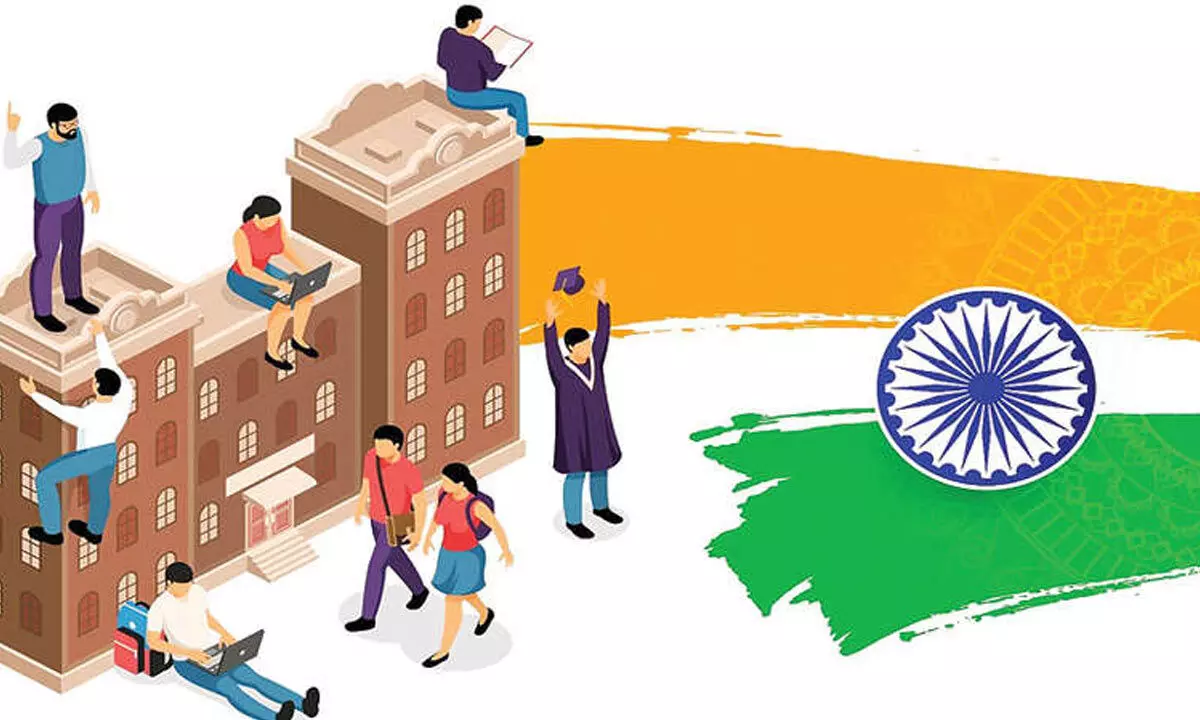Most Indians missing out on higher education will dent prospects of achieving Viksit Bharat

The ground reality puts to shade the hype around empowerment of SCs, STs and OBCs
India aims to increase its gross enrolment ratio(GER) – the ratio of people enrolled in higher education to the population – in higher education from 27 per cent to 50 per cent by 2030. It is an important goal and must be achieved as we strive towards becoming an inclusive Viksit Bharat by 2047. On January 25, the Union Ministry of Education released the All India Survey on Higher Education (AISHE) 2021-2022. It says the enrolment in higher education increased to 4.33 crore in 2021-22 from 4.14 crore in 2020-21 and 3.42 crore in 2014-15, an increase of 26.5 per cent since 2014-15. The female enrolment in higher education went up to 2.07 crore in 2021-22 from 1.57 crore in 2014-15, which is a 32 per cent increase.
Let us look at some more details of AISHE-2021-22. It also says that there is a significant 44 per cent increase in enrolment of SC students since 2014-15 -- 66.23 lakh in 2021-22 from 46.07 lakh in 2014-15. A notable increase of 51 per cent in enrolment of female SC students in 2021-22 - 31.71 lakh as compared to 21.02 lakh in 2014-15! According to Census 2011, the number of Scheduled Castes is 20,13, 78086, which is 16.6 per cent of the total population. Their population must have gone up to 20 per cent now. So, only a small percentage of SC youth is getting higher education in our country, which is not a healthy sign at all.
What about Scheduled Tribes (STs)? The AISHE report says that there was a substantial increase of 65.2 per cent in the enrolment of ST students in 2021-22 (27.1 lakh) as compared to 16.41 lakh in 2014-15. There was an 80 per cent increase in the enrolment of female ST students in 2021-22 (13.46 lakh) since 2014-15 (7.47 lakh). Their population, as per the Census 2011, is 10, 42, 81,034, which is 8.6 per cent of the total population of India. It must have gone up to 12 per cent by now. So, we can see that the majority of ST youth are not going to college even after over seven decades of Independence.
It is an agonizing situation which must jolt the conscience of every true India. We need to pause and ponder over what kind of progress we are going to celebrate when India completes 100 years of Independence. Will it be a celebration of equality and inclusivity or disparities and deprivations? It is an alarm bell for the policy makers and all other stakeholders to swing into action, the sooner the better. What about Other Backward Class (OBC) students? The AISHE report says that there was an increase of 45 per cent in OBC student enrolment in 2021-22 (1.63 crore) from 1.13 crore in 2014-15. An increase of 49.3 per cent was witnessed in the enrolment of female OBC students in 2021-22 (78.19 lakh) since 2014-15 (52.36 lakh).
The ground reality is so debilitating. It does not match with hype and hoopla being created around the empowerment of SCs, STs and OBCs, who have a lion’s share in the country’s population but their children are not going to colleges and universities. Similarly, the minority student enrolment was 30.1 lakh in 2021-22 as compared to 21.8 lakh in 2014-15, an increase of 38 per cent. The AISHE-2021-22 report put the female minority student enrolment at 15.2 lakh in 2021-22 from 10.7 lakh in 2014-15, a 42.3 per cent increase. Thus, SCs, STs, OBCs and minority communities, who account for over 80 per cent of the country’s population, are sending only a fraction of their children to higher education institutions (HEIs). Their number would be much less in HEIs in the private sector.
Let us decipher some more data from the report of AISHE 2021-22. It also says that about 78.9 per cent of the total students are enrolled in undergraduate level courses and 12.1 per cent are enrolled in postgraduate level courses. Among disciplines at under-graduate level in AISHE 2021-22, enrolment was found to be the highest in Arts (34.2 pc), followed by science (14.8 pc), Commerce (13.3 pc) and Engineering and Technology (11.8 pc). Among streams at postgraduate level in AISHE 2021-22, maximum students are enrolled in Social Science (21.1 pc) followed by science (14.7 pc). The Ph D enrolment has increased by 81.2 pc to 2.12 lakh in 2021-22 as compared to 1.17 lakh in 2014-15. One can just imagine the number of SC, ST and OBC students pursuing Graduate and Post Graduate courses in different streams. The less we talk about their share in PhD enrolment the better.
Last but not the least, the total number of pass-outs increased to 1.07 crore in 2021-22 as against 95.4 lakh in 2020-21. Do we have the break-up to know the pass percentage of SC, ST and OBC students? Perhaps, such data are not in the public domain!
The need of the hour is to launch a special drive to enroll more and more students from weaker sections of society to increase their GER to 50 per cent and pass percentage to 100 per cent. The government universities, constituting 58.6 per cent of total universities and contributing 73.7 per cent of total enrolment, and private universities, accounting for 26.3 per cent of total enrolment, should work in a mission mode in this regard. They should also put in place a foolproof mechanism for tutorial classes to increase the pass percentage of students from deprived social groups.
As per the Union Ministry of Education, the total number of universities/university level institutions registered is 1,168; colleges 45,473 and standalone institutions 12,002. Around 17 universities, including 14 state public varsities and 4,470 colleges are exclusively for women. In the circumstances, what is required is nothing but a strong political will to use education as a tool to transform the country inclusively.
As a nation, we are still waiting for the real milestone moment when we see a major chunk of eligible youth from weaker sections of society entering the seats of higher education with their head held high.

















